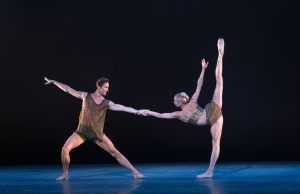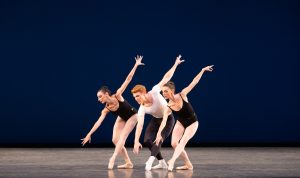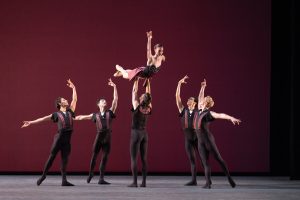
The dancers of Miami City Ballet did themselves proud performing an exciting and strikingly different choreographic work in the company’s Spring Mix program at the Kravis Center for the Performing Arts on March 23. Nestled between two more traditional-style works for the company to perform was the company premiere of visionary choreographer Alonzo King’s Following the Subtle Current Upstream.
Not only was the movement in this work unfamiliar to the MCB dancers to perform, the rehearsal process of having this work set on the company was novel. When learning any of King’s works, the key elements required are commitment, exploration and play. King’s approach to choreography is a method that he has developed into a technique he uses with the Alonzo King Lines Ballet company members and is taught to dance students at King’s San Francisco school.
According to Meredith Webster, whether working with dancers from his own company or a guest company, King encourages dancers to take on the movement as their own and works with then to find their own individuality within it to make the work “sing.” Webster, who was a dancer in King’s company for nine years before becoming his rehearsal mistress, set Following the Subtle Current Upstream on MCB. Webster is not a stranger to South Florida, as she received part of her formal ballet training at the Harid Conservatory in Boca Raton.
Following the Subtle Current Upstream was originally created in 2000 for the Alvin Ailey American Dance Theatre by then-Artistic Director Judith Jamison, who specifically requested that King create a work in which the modern dancers of Ailey would have to move differently than they were used to moving. Over the last couple of decades, this work has been set on various ballet companies and probably for exactly the same reason — King’s methodology and movement style are a creative foray for the classically trained dancer.
King’s works, like George Balanchine’s dances, are story-less ballets but unlike Balanchine’s, King’s works are not gender-specific. He bases his works on what he calls “thought structures.” In this work, set to music by tabla maestro Zakir Hussain, a frequent King collaborator, as well as experimental American composer Miguel Frasconi and South African singer Miriam Makeba, King explored the instinct to return home and posed the central question, “How do we return to joy?”
Costume Designer Robert Rosenwasser used a muted palette for his minimal contemporary costumes that sleekly complemented the bold, stark lightning originally designed by Axel Morganthaler and recreated by Al Crawford.

A trio of men, highlighted in downward amber lights, moved to sparse sound laced with moments of silence, pulling and stretching each other until Steven Loch entered to sounds of thunder and introduced his own array of interesting — almost awkward — movement. The trio then began to manipulate Loch’s movement, making him look as if he was caught in an underwater current.
In silence, a trio of women danced together as well as the tall and coltish Mary Kate Edwards, who was cast in one of the central roles. Her movement, particularly in her solo, was quirky and fast; again, it seemed slightly awkward but proved to be completely fascinating.
Also eye-catching were Dawn Atkins, Hannah Fischer and Cameron Catazaro in their weighted and sensual duet, Satoki Habuchi, and the standout duo Natalia Arja and Anna Greenberg dancing with clarity and attack to the rapid polyrhythmic drumming of the last ensemble section.
Opening the evening on this third program of MCB’s season was one of George Balanchine’s masterworks, Agon, which was choreographed for the New York City Ballet in 1957. One of the first of many collaborations between Balanchine and composer Igor Stravinsky, Agon combined two Old World historical references with the New World and modern sensibilities of the two Russian-born men who now called America their home.
Sparked by dance and musical structures of the 17th century, they created a work that is considered to be one of the most influential of the 20th century. With a bare stage and dancers dressed in non-costumes (simple ballet rehearsal clothes), the two reworked the stately court dances of Baroque France (such as the sarabande and the galliard) with the 12-tone music of the 1950s. Each developed their own symmetrical and asymmetrical patterns and arrangements that played off each other brilliantly.
The central pas de deux, danced on March 23 by Dawn Atkins and Stanislav Olshanskyi, was a strong departure for Balanchine at that time. Rather than using the usual female supported by male style of the classical pas de deux, the partnering in this extended duet was filled with tension that built and strained as the couple intertwined in locked energy, creating a more equal relationship between the duo.

Closing the evening was Delight, an energetic and step-laden ensemble work for 18 dancers by Brazilian-born choreographer Ricardo Amarante, set to music by Johann Sebastian Bach. The aptly titled work was a stream of traditional balletic movement that swirled and soared amidst a series of transparent pale gray pleated scrims that added a welcome visual dimension to the work as they were dropped and raised during the different sections of the dance.
The costumes, designed by René Salazar David, had a traditional ballet look to them with the women in rusty red and black, knee-length dresses with a strapless bodice and the men in black tights and tunic tops with rust red accents.
The dancers — the three lead females, Jennifer Lauren, Samantha Hope Galler and Jordan-Elizabeth Long, and their partners Alexander Peters, Cameron Catazaro and Chase Swatosh respectively, as well as the other 12 demi-soloists — had no trouble keeping pace with the quick tempo played by Miami City Ballet Orchestra under the baton of Gary Sheldon. With unflagging energy, they met to soar high in lifts or to dip in swooning embraces before exiting to reappear and repeat another arrangement of familiar ballet steps.
Amarante, who was inspired by the bravura of Bach’s Keyboard Concerto No. 1 (in D minor, BWV 1052, played by guest pianist Ciro Foderé), felt the urge to celebrate the art form that is dance by trying to capture the exhilaration felt in performance as the human body transcends from the ordinary to beauty and grace. Fast and full to the brim with a multitude of steps and patterns, it was an almost over-the-top work that served well as a rousing closer to the March 23 show.